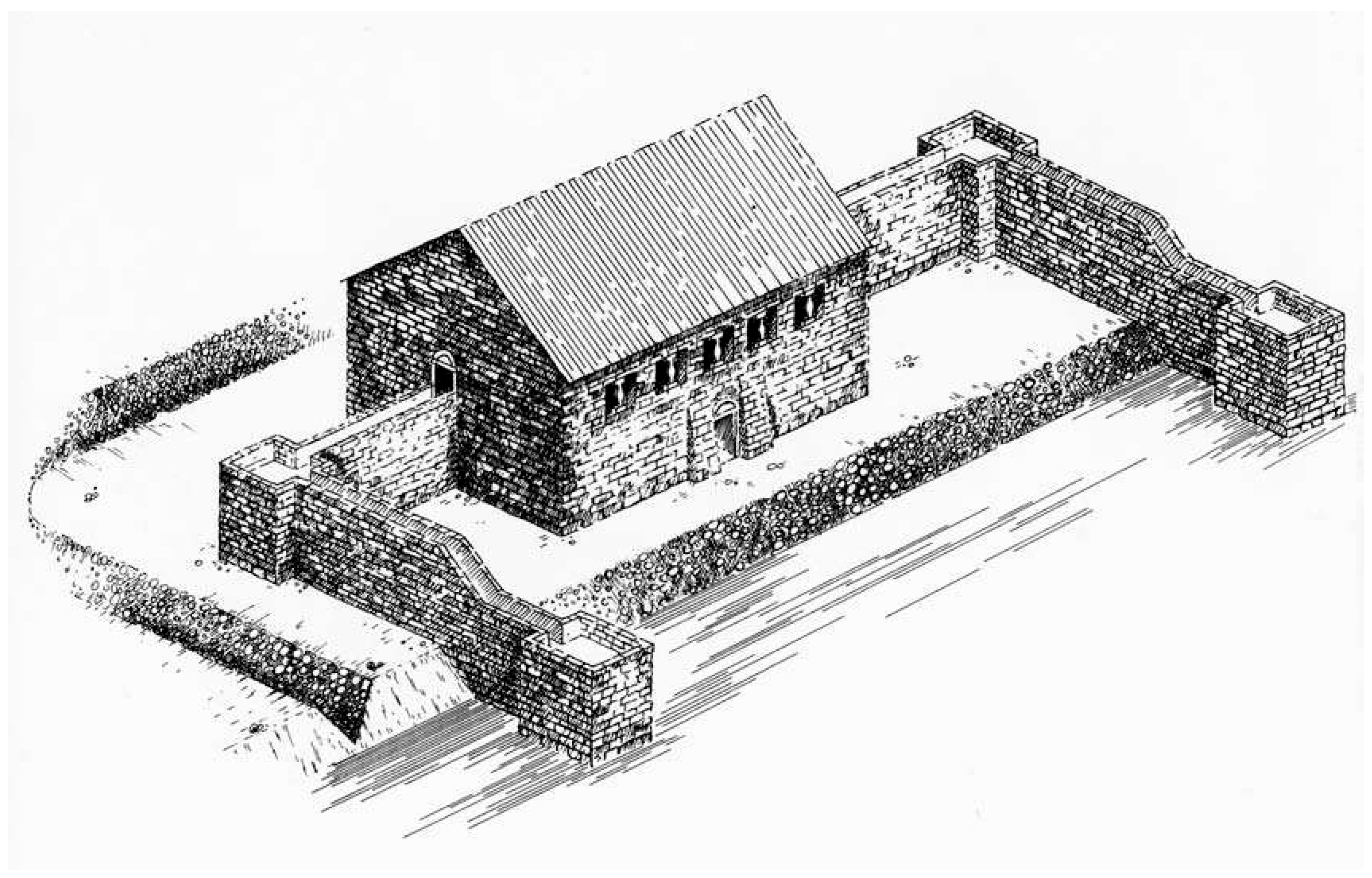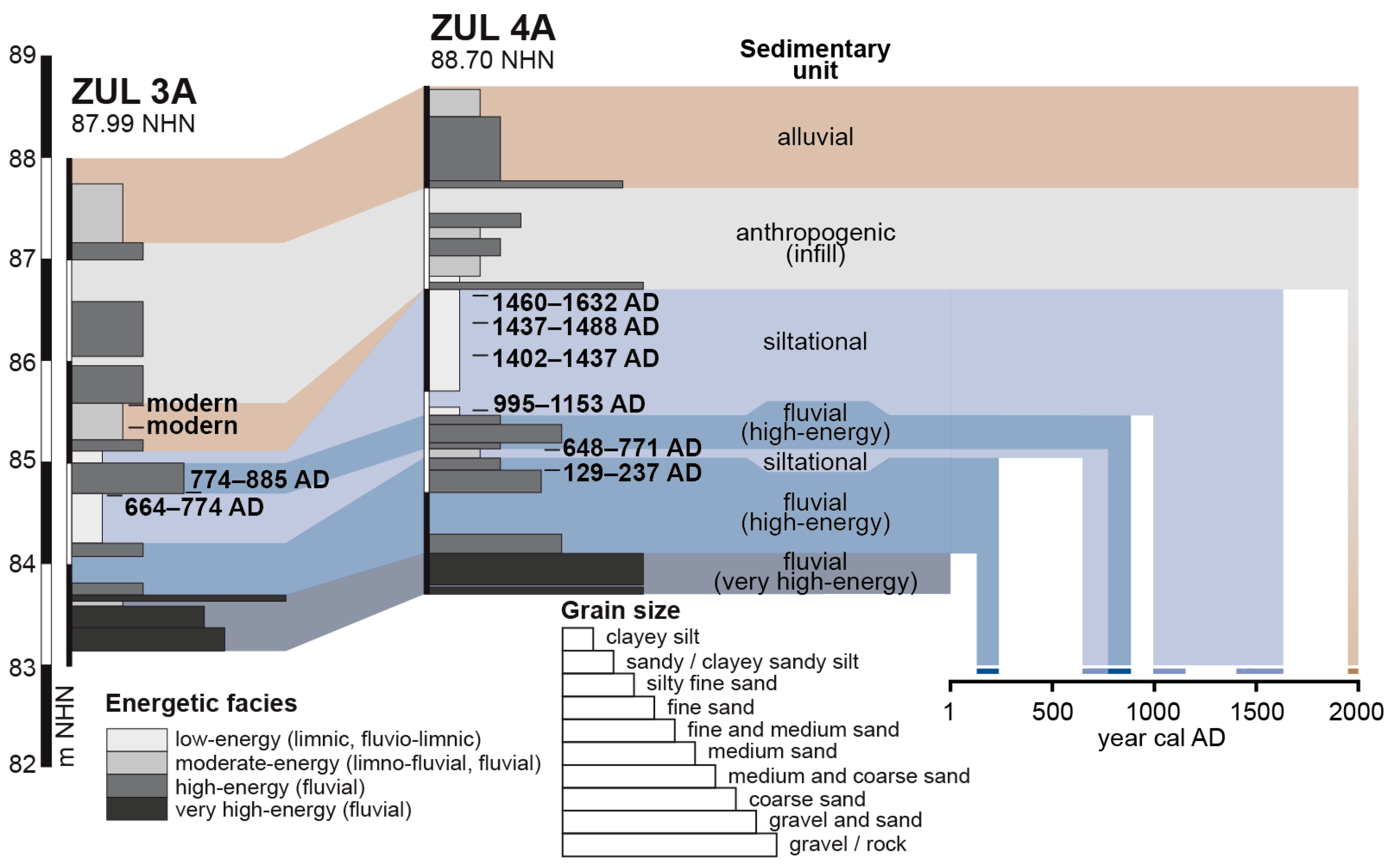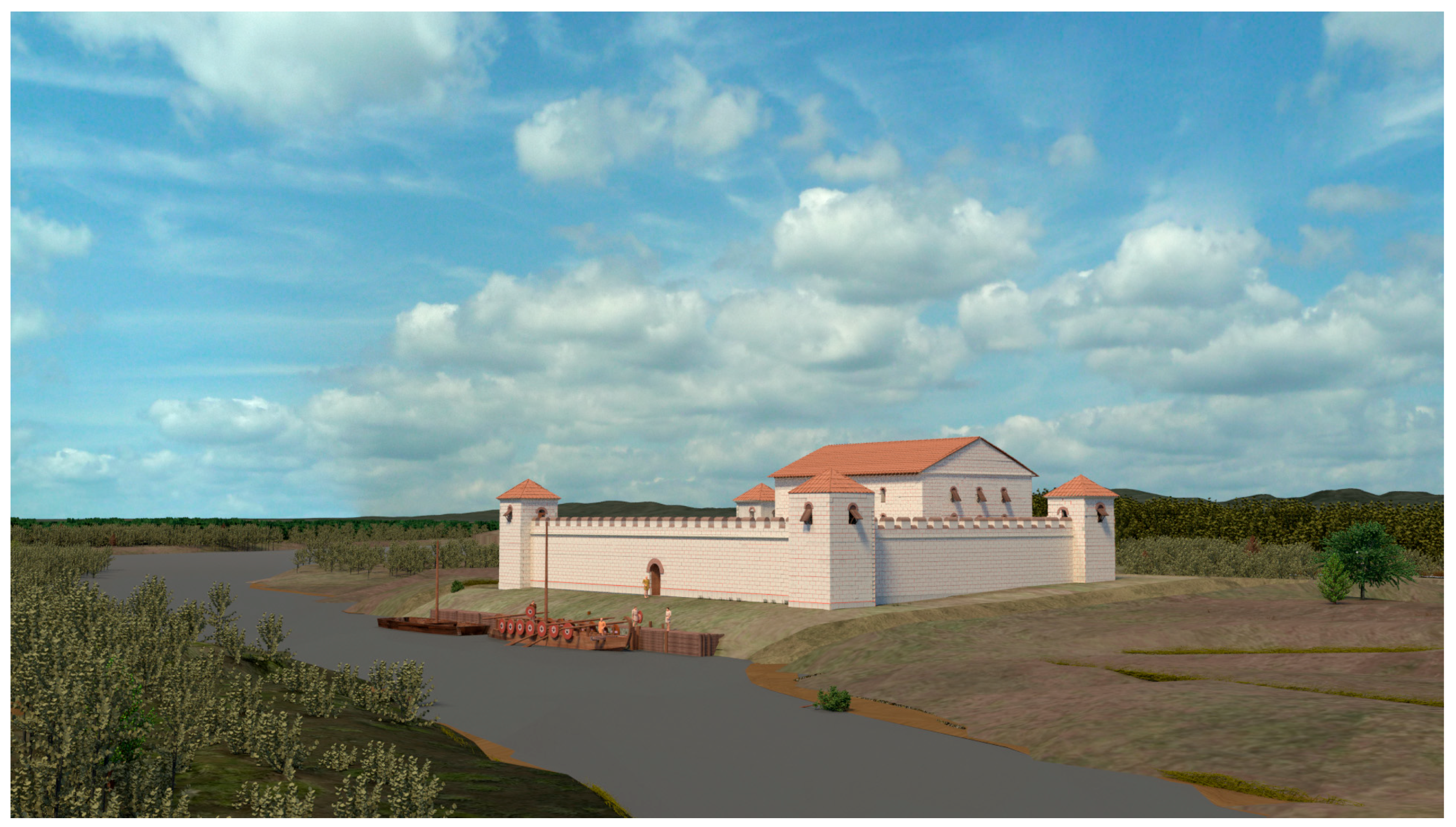A Roman Fortlet and Medieval Lowland Castle in the Upper Rhine Graben (Germany): Archaeological and Geoarchaeological Research on the Zullestein Site and the Fluvioscape of Lorsch Abbey
Abstract
1. Introduction
2. Re-Evaluation of Materials
3. Materials and Methods
4. Results
5. Discussion
5.1. Geoarchaeological Reconstruction of the Zullestein Surroundings
5.2. DEM and Historical Data Analyses
6. Conclusions
Supplementary Materials
Author Contributions
Funding
Data Availability Statement
Acknowledgments
Conflicts of Interest
Abbreviations
| AD | Anno Domini |
| b.s. | Below surface |
| cal | Calibrated |
| DEM | Digital elevation model |
| DP | Direct push |
| ERT | Electrical resistivity tomography |
| HPT | Hydraulic profiling tool |
| NHN | Normalhöhennull (elevation above the German vertical datum) |
References
- Haass, J.H. I. Bogen Der Angekündigten Situations-Charte, Aufgenommen Und Gezeichnet Durch Haass, Artillerie-Lieutenant Zu Darmstadt (Kartenwerk Zum 1. Koalitionskrieg). Blatt 7: Westhofen, Worms Und Wachenheim 1795. Available online: http://www.landesarchiv-bw.de/plink/?f=1-1297816 (accessed on 14 May 2025).
- Eckhardt, C.L.P.; Hirsch, A. Nördliche Fortsetzung Der Topographischen Charte von Schwaben. Blatt Mannheim 1833. Available online: https://arcinsys.hessen.de/arcinsys/digitalMediaViewer.action?archivalDescriptionId=3466536&selectId=3902839 (accessed on 14 May 2025).
- Jorns, W. Zullenstein: Ein Beitrag zur Kontinuität von Bauwerken. In Deutsche Königspfalzen. Beiträge zu Ihrer Historischen und Archäologischen Erforschung; Fleckenstein, J., Ed.; Veröffentlichungen des Max-Planck-Instituts für Geschichte; Vandenhoeck & Ruprecht: Göttingen, Germany, 1979; Volume 3, pp. 111–135. [Google Scholar]
- Jorns, W. Der spätrömische Burgus mit Schiffslände und die karolingische Villa Zullestein. Archäologisches Korresp. 1973, 3, 75–80. [Google Scholar]
- Jorns, W. Der Spätrömische Burgus Zullestein Mit Schiffslände, Nördlich von Worms. In Actes du IXe Congrès International d’Études sur les Frontières Romaines; Pippidi, D.M., Ed.; Editura Academiei: Bucuresti, Romania, 1974; pp. 427–432. [Google Scholar]
- Jorns, W. Die Burg Stein: Bericht über die Archäologischen Untersuchungen 1971-73. Geschichtsblätter Kreis Bergstraße 1978, 11, 35–72. [Google Scholar]
- Kunz, R.; Jorns, W.; von Brockhusen, H.J. Die Burg Stein; Veröffentlichungen des Amts für Bodendenkmalpflege Darmstadt; Selbstverlag: Darmstadt, Germany, 1971. [Google Scholar]
- Kunter, M. Frühkarolingische Skelettreste vom Zullestein, Gem. Nordheim, Lkr. Bergstraße. Z. Für Morphol. Und Anthropol. 1974, 65, 305–323. [Google Scholar] [CrossRef]
- Kunter, M. Frühkarolingische Skelettreste vom Zullestein, Gem. Nordheim, Lkr. Bergstraße. Ver. Für Heimatgeschichte Nord. 2006, 20, 360–364. [Google Scholar]
- Herrmann, F.-R. Der Zullenstein an Der Weschnitzmündung: Führungsblatt Zu Dem Spätrömischen Burgus, Dem Karolingischen Königshof Und Der Veste Stein Bei Biblis-Nordheim, Kreis Bergstraße; Archäologische Denkmäler in Hessen; Archäologische Denkmalpflege im Landesamt für Denkmalpflege in Hessen: Wiesbaden, Germany, 1989; Volume 82. [Google Scholar]
- Siemers, S.-H. Von der karolingischen Handelssiedlung “Zullestein” zur Festung “Zum Stein” bei Biblis-Nordheim, Kreis Bergstrasse. Eine Auswertung der Funde der Ausgrabung “Schloßbuckel”. Ph.D. Thesis, Johannes Gutenberg-Universität Mainz, Mainz, Germany, 2001. [Google Scholar]
- Siemers, S.-H. Von Der Karolingischen Handelssiedlung “Zullestein” Zur Festung “Zum Stein” Bei Biblis-Nordheim, Kr. Bergstrasse. Archäologisches Nachrichtenblatt 2002, 7, 336–339. [Google Scholar]
- Siemers, S.-H. Gelbes Blei aus dem Oberrheingraben. Ein Aussergewöhnlicher Glasbecher aus der Burg Stein (Gem. Biblis-Nordheim/ Kr. Bergstraße). 2007. Available online: https://www.academia.edu/5953650/Gelbes_Blei_aus_dem_Oberrheingraben (accessed on 14 May 2025).
- Schwarz, K. Die römische Schiffslände Zullestein. Aspekte zur spätrömischen Grenzverteidigung in den Nordwestprovinzen unter besonderer Berücksichtigung der Ländeburgi. Ph.D. Thesis, Johannes Gutenberg-Universität Mainz, Mainz, Germany, 2009. [Google Scholar]
- Bakker, L. Die Spätrömische Schiffsländen Am Rhein. Die Burgi von Niederlahnstein Und Biblis-”Zullestein”. In Berichte zur Archäologie an Mittelrhein und Mosel; Wegner, H.-H., Ed.; Gesellschaft für Archäologie an Mittelrhein und Mosel e.V.: Koblenz, Germany, 2014; Volume 20, pp. 33–155. ISBN 978-3-9811687-9-2. [Google Scholar]
- Becker, T.; Janotka, N.; Mächtle, B.; Obrocki, L.; Prien, R.; Vött, A. Das neue Bild vom alten Burgus. Neue Forschungen zum “Zullestein” bei Biblis (Lkr. Bergstraße) und zu dessen Umfeld. In hessenARCHÄOLOGIE 2019; hessenARCHÄOLOGIE, Ed.; Jahrbuch für Archäologie und Paläontologie in Hessen; wbg Theiss: Darmstadt, Germany, 2020; pp. 133–137. ISBN 978-3-8062-4224-9. [Google Scholar]
- Prien, R. Der spätantike burgus von Ladenburg-eine Neubewertung. In LOPODUNUM VII: Ladenburg und der Lobdengau zwischen ‚Limesfall‘ und den Karolingern; Prien, R., Witschel, C., Eds.; Forschungen und Berichte zur Archäologie in Baden-Württemberg; Reichert Verlag: Wiesbaden, Germany, 2020; Volume 17, pp. 121–146. ISBN 978-3-95490-707-6. [Google Scholar]
- Becker, T. Historische Gewässernutzung in Südhessen. Das Landgraben- Und Das Weschnitz-Projekt. Denkmal Hess. 2023, 2, 46–49. [Google Scholar] [CrossRef]
- Henselowsky, F.; Becker, T.; Bubenzer, O.; Mächtle, B.; Schenk, G.J.; Vött, A. Wechselbeziehungen Zwischen Der Flusslandschaft Der Weschnitz Und Dem Kloster Lorsch. Interdisziplinäres Forschungsprojekt „Auf Dem Weg Zur Fluvialen Anthroposphäre“ Im Landkreis Bergstraße. In HessenARCHÄOLOGIE 2023; Jahrbuch für Archäologie und Paläontologie in Hessen; wbg Theiss: Darmstadt, Germany, 2024; pp. 294–299. ISBN 978-3-89822-354-6. [Google Scholar]
- Rolfe, J.C. Ammianus Marcellinus: History. Books 27–31. Excerpta Valesiana; Loeb Classical Library; Harvard University Press: Cambridge, MA, USA, 1939; Volume 331. [Google Scholar]
- Saylor Rodgers, B. Symmachus. Oration II. To Valentinian. 1 January 370 2015. Available online: https://www.uvm.edu/~bsaylor/ (accessed on 14 May 2025).
- Prien, R.; Witschel, C. Zwischen Backofen und Burgus. Überlegungen zur Rolle von Lopodunum im Gefüge des spätantiken Grenzraums am Unteren Neckar. In Von Hammaburg nach Herimundesheim. Festschrift für Ursula Koch; Wieczorek, A., Wirth, K., Eds.; Mannheimer Geschichtsblätter: Sonderveröffentlichung; Verlag Regionalkultur: Ubstadt-Weiher, Germany, 2018; Volume 11, pp. 67–76. ISBN 978-3-95505-106-8. [Google Scholar]
- Bockius, R. Die Spätrömischen Schiffswracks Aus Mainz: Schiffsarchäologisch-Technikgeschichtliche Untersuchung Spätantiker Schiffsfunde Vom Nördlichen Oberrhein; Monographien des RGZM.; Verlag des Römisch-Germanischen Zentralmuseums: Mainz, Germany, 2006; ISBN 978-3-96929-356-0. [Google Scholar]
- Appel, E.; Becker, T.; Wilken, D.; Obrocki, L.; Fischer, P.; Willershäuser, T.; Henselowsky, F.; Vött, A. The Roman Burgus at Trebur-Astheim and Its Relation to the Schwarzbach/Landgraben Watercourse (Hessisches Ried, Germany) Based on Geophysical and Geoarchaeological Investigations. Z. Für Geomorphol. 2024. preprint. [Google Scholar] [CrossRef]
- Appel, E.; Becker, T.; Schäfer, H.; Scholz, M.; Vött, A.; Wilken, D. Ergebnisse aus dem DFG-Projekt “Landgraben”. Neue Untersuchungen im Umfeld des römerzeitlichen Schiffsländeburgus von Trebur-Astheim. In hessenARCHÄOLOGIE 2024; Jahrbuch für Archäologie und Paläontologie in Hessen; wbg Theiss: Darmstadt, Germany, 2025; in print. [Google Scholar]
- Heising, A. Der Schiffslände-Burgus von Trebur-Astheim: Schicksal einer Kleinfestung in Spätantike und frühem Mittelalter. In Das Gebaute und das Gedachte: Siedlungsform, Architektur und Gesellschaft in Prähistorischen und Antiken Kulturen; Raeck, W., Steuernagel, D., Eds.; Frankfurter archäologische Schriften; Verlag Dr. Rudolf Habelt: Bonn, Germany, 2012; pp. 151–166. ISBN 978-3-7749-3816-8. [Google Scholar]
- Mráv, Z. Dunakeszi-Late Roman Fortlet Along the Danube. In Guide to Hungarian Sites of the Roman Limes that Are Nominated for World Heritage Status; National Office of Cultural Heritage: Budapest, Hungary, 2011; Volume 1, ISBN 978-963-08-0841-5. [Google Scholar]
- Hessische Verwaltung für Bodenmanagement und Geoinformation Digitales Geländemodell (DGM1) 2023. Available online: https://gds.hessen.de/INTERSHOP/web/WFS/HLBG-Geodaten-Site/de_DE/-/EUR/ViewDownloadcenter-Start?path=3D-Daten/Digitales%20Gel%C3%A4ndemodell%20(DGM1) (accessed on 14 May 2025).
- Ad-hoc-Arbeitsgruppe Boden. Bodenkundliche Kartieranleitung, 5th ed.; Schweizerbart’sche Verlagsbuchhandlung: Hannover, Germany, 2005; ISBN 978-3-510-95920-4. [Google Scholar]
- Amelung, W.; Blume, H.-P.; Fleige, H.; Horn, R.; Kandeler, E.; Kögel-Knabner, I.; Kretzschmar, R.; Stahr, K.; Wilke, B.-M. Scheffer/Schachtschabel Lehrbuch der Bodenkunde; Springer: Berlin/Heidelberg, Germany, 2018; ISBN 978-3-662-55870-6. [Google Scholar]
- Reimer, P.J.; Austin, W.E.N.; Bard, E.; Bayliss, A.; Blackwell, P.G.; Bronk Ramsey, C.; Butzin, M.; Cheng, H.; Edwards, R.L.; Friedrich, M.; et al. The IntCal20 Northern Hemisphere Radiocarbon Age Calibration Curve (0–55 Cal kBP). Radiocarbon 2020, 62, 725–757. [Google Scholar] [CrossRef]
- Stuiver, M.; Reimer, P.J. Extended 14C Data Base and Revised CALIB 3.0 14C Age Calibration Program. Radiocarbon 1993, 35, 215–230. [Google Scholar] [CrossRef]
- Anonymous Wahre Abbildung deß Vesten Orthß Stein so den 21. Augusti Anno 1621. von den Spanischen Erobert, Sambt Denselben Schantzen und Schiffbrucken Daselbsten; 1621. Available online: https://nat.museum-digital.de/object/1239414 (accessed on 14 May 2025).
- Merian, M.; Zeiller, M. (Eds.) Topographia Palatinatus Rheni et Vicinarum Regionum; Mattheum Merian: Frankfurt am Main, Germany, 1645. [Google Scholar] [CrossRef]
- Appel, E.; Becker, T.; Wilken, D.; Fischer, P.; Willershäuser, T.; Obrocki, L.; Schäfer, H.; Scholz, M.; Bubenzer, O.; Mächtle, B.; et al. The Holocene Evolution of the Fluvial System of the Southern Hessische Ried (Upper Rhine Graben, Germany) and Its Role for the Use of the River Landgraben as a Waterway during Roman Times. EG Quat. Sci. J. 2024, 73, 179–202. [Google Scholar] [CrossRef]
- Hessisches Landesamt für Naturschutz, Umwelt und Geologie Lorsch Weschnitz Gewässerdurchfluss Tagesmittelwerte. Messstellennummer 23942300. 2025. Available online: https://www.hlnug.de/static/pegel/wiskiweb3/webpublic/#/overview/Wasserstand/station/41276/Lorsch/download (accessed on 14 May 2025).
- Gerlach, R.; Meurers-Balke, J.; Kalis, A.J. The Lower Rhine (Germany) in Late Antiquity: A Time of Dissolving Structures. Neth. J. Geosci. 2022, 101, e14. [Google Scholar] [CrossRef]
- Roggenkamp, T.; Herget, J. Middle and Lower Rhine in Roman Times: A Reconstruction of Hydrological Data Based on Historical Sources. Environ. Earth Sci. 2016, 75, 1100. [Google Scholar] [CrossRef]
- Schirmer, W.; Bos, J.A.A.; Dambeck, R.; Hinderer, M.; Preston, N.; Schulte, A.; Schwalb, A.; Wessels, M. Holocene Fluviatile Processes and Valley History in the River Rhine Catchment. Erdkd. Arch. Sci. Geogr. 2005, 59, 199–215. [Google Scholar] [CrossRef]
- Minst, K.J. Lorscher Codex: Deutsch; Urkundenbuch Der Ehemaligen Fürstabtei Lorsch; Lorscher Codex; Verlag Laurissa: Lorsch, Germany, 1966; Volume 1. [Google Scholar] [CrossRef]
- Landesgeschichtliches Informationssystem Hessen Burg Zullenstein, Landkreis Bergstraße. Historisches Ortslexikon 2024. Available online: https://www.lagis-hessen.de/de/subjects/idrec/sn/ol/id/13205 (accessed on 14 May 2025).
- Rüstow, W. Militärisches Hand-Wörterbuch. Nach Dem Standpunkte Der Neuesten Litteratur Und Mit Unterstützung von Fachmännern. M Bis Z.; Friedrich Schultheß: Zürich, Switzerland, 1859; Volume 2. [Google Scholar]
- Landesamt für Denkmalpflege Hessen. Archive: Außenstelle Darmstadt Nordheim 050. EV DA 2019: 0027 2019.
- Landesamt für Denkmalpflege Hessen. Archive: Außenstelle Darmstadt Biblis 054. EV DA 2014: 0132 2014.







| Sample | Lab. No. MAMS | Depth (m b.s.) | Depth (m NHN) | Material | δ13C | 14C Age (BP) | +/− | 1 σ Max-Min (cal AD) | 2 σ Max-Min (cal AD) |
|---|---|---|---|---|---|---|---|---|---|
| Zul 3A/17 HR 2.43 | 42763 | 2.43 | 85.56 | wood | −27.7 | −3348 | 17 | modern | modern |
| Zul 3A/19 HR 2.65 | 42764 | 2.65 | 85.34 | wood | −27.8 | −1168 | 18 | modern | modern |
| Zul 3A/26 HR 3.29 | 42765 | 3.29 | 84.7 | wood | −30.4 | 1199 | 20 | 775–880 | 774–885 |
| Zul 3A/27 PR 3.32 | 42766 | 3.32 | 84.67 | plant fragment | −28.8 | 1294 | 21 | 674–773 | 664–774 |
| Zul 4A/18 HK 2.06 | 42767 | 2.06 | 86.64 | charcoal | −25.1 | 356 | 19 | 1478–1621 | 1460–1632 |
| Zul 4A/20 PR/HR 2.33 | 42768 | 2.33 | 86.37 | plant fragment | −26.4 | 419 | 19 | 1445–1469 | 1437–1488 |
| Zul 4A/24 HR 2.65 | 42769 | 2.65 | 86.05 | wood | −31.9 | 517 | 20 | 1409–1426 | 1402–1437 |
| Zul 4A/28 HR 3.19 | 42770 | 3.19 | 85.51 | wood | −27.4 | 988 | 22 | 1022–1123 | 995–1153 |
| Zul 4A/33 PR 3.58 | 42771 | 3.58 | 85.12 | plant fragment | −28.6 | 1349 | 20 | 653–671 | 648–771 |
| Zul 4A/35 HR2 3.78 | 42772 | 3.78 | 84.92 | wood | −28.6 | 1850 | 21 | 132–235 | 129–237 |
Disclaimer/Publisher’s Note: The statements, opinions and data contained in all publications are solely those of the individual author(s) and contributor(s) and not of MDPI and/or the editor(s). MDPI and/or the editor(s) disclaim responsibility for any injury to people or property resulting from any ideas, methods, instructions or products referred to in the content. |
© 2025 by the authors. Licensee MDPI, Basel, Switzerland. This article is an open access article distributed under the terms and conditions of the Creative Commons Attribution (CC BY) license (https://creativecommons.org/licenses/by/4.0/).
Share and Cite
Prien, R.; Appel, E.; Becker, T.; Bubenzer, O.; Fischer, P.; Mächtle, B.; Willershäuser, T.; Vött, A. A Roman Fortlet and Medieval Lowland Castle in the Upper Rhine Graben (Germany): Archaeological and Geoarchaeological Research on the Zullestein Site and the Fluvioscape of Lorsch Abbey. Heritage 2025, 8, 180. https://doi.org/10.3390/heritage8050180
Prien R, Appel E, Becker T, Bubenzer O, Fischer P, Mächtle B, Willershäuser T, Vött A. A Roman Fortlet and Medieval Lowland Castle in the Upper Rhine Graben (Germany): Archaeological and Geoarchaeological Research on the Zullestein Site and the Fluvioscape of Lorsch Abbey. Heritage. 2025; 8(5):180. https://doi.org/10.3390/heritage8050180
Chicago/Turabian StylePrien, Roland, Elena Appel, Thomas Becker, Olaf Bubenzer, Peter Fischer, Bertil Mächtle, Timo Willershäuser, and Andreas Vött. 2025. "A Roman Fortlet and Medieval Lowland Castle in the Upper Rhine Graben (Germany): Archaeological and Geoarchaeological Research on the Zullestein Site and the Fluvioscape of Lorsch Abbey" Heritage 8, no. 5: 180. https://doi.org/10.3390/heritage8050180
APA StylePrien, R., Appel, E., Becker, T., Bubenzer, O., Fischer, P., Mächtle, B., Willershäuser, T., & Vött, A. (2025). A Roman Fortlet and Medieval Lowland Castle in the Upper Rhine Graben (Germany): Archaeological and Geoarchaeological Research on the Zullestein Site and the Fluvioscape of Lorsch Abbey. Heritage, 8(5), 180. https://doi.org/10.3390/heritage8050180






